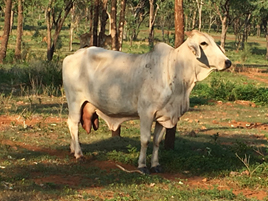Udder quality is a trait that most cattlemen focus on. It is well known that “bad bags” or swollen udders can cause havoc during calving season. But are those less than perfect udders more than just an eye sore? Does a bad quarter or big teat cause performance issues with calves?
Recently in Northern Australia, a group of researchers lead by Tim Scahtz and the CalthWatch Project have been closely monitoring how bottle teats impact calfhood health and performance. Over a two year period, 200 head of cows were monitored at calving to see what impact bottle teats had. Within this herd the most common cause of calf loss immediately after calving was bottle teats on the cow. During this study 5-6% of all the calf losses within this herd were attributed to bottle teats on the cow.
Compounding the issue, many of the cows that had bottle teats at calving, had moderately normal looking teats a few weeks after calving, making it very difficult to identify these cows, if they were in a large herd and they are not identified soon after calving.
These findings are not an isolated case, J.E. Frisch published in the Cambridge Press in 2010 with similar findings. They measured teats of 892 cows within two days of calving. Within this group, bottle teats were the single most attributed factor to calf loss, up to 2 months of age. Furthermore, when all four teats were enlarged, calf loss skyrocketed. However, calves that were born to cows with at least one bottle teat, that survived to weaning were typically heavier calves. However, producers need to keep in mind that udder shape and quality is a moderately heritable trait. So while the calves from these cows maybe heavier at calving, if replacement heifers are kept from these cows, it is likely a problem that will continue to increase in your herd.
Bottle teats come from the breakdown of elasticity of the teat and it will not correct itself. Once a bottle teat forms, it will return to that shape again. When the cows start to produce colostrum, before birth, the pressure of the milk begins to stretch out the shape of the teat, making this more common in heavy milking cows. While one bottle teat doesn’t seem make a major difference on performance of the cow, it is likely that over time she will develop more. The major issue is that at calving these teats are extremely rigid, making it difficult for youth calves to nurse. This results in decreased colostrum intake and in some cases calf loss, if not closely monitored.
This is an issue that producers need to be aware of. Especially when selecting genetics to add to the herd. A dry/non-lactating cow with bottle teats can be hard to identify. Udder quality is something that makes a major difference in calf health and survival for the first two months post-calving, and should be kept in mind when making future culling and selection discussions.
- Big Doe Contest Returns for 2025: A Growing Thanksgiving Tradition - November 14, 2025
- UF/IFAS Extension Panhandle Cattlemen’s College Announces Scholarship Opportunity for Florida Youth – Application Deadline September 15 - August 29, 2025
- Foot Rot Prevention and Treatment for Cattle - August 15, 2025

